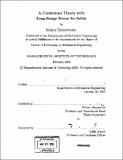| dc.contributor.advisor | Rohan Abeyaratne. | en_US |
| dc.contributor.author | Zimmermann, Markus, 1976- | en_US |
| dc.contributor.other | Massachusetts Institute of Technology. Dept. of Mechanical Engineering. | en_US |
| dc.date.accessioned | 2006-03-24T18:42:00Z | |
| dc.date.available | 2006-03-24T18:42:00Z | |
| dc.date.copyright | 2005 | en_US |
| dc.date.issued | 2005 | en_US |
| dc.identifier.uri | http://hdl.handle.net/1721.1/30342 | |
| dc.description | Thesis (Ph. D.)--Massachusetts Institute of Technology, Dept. of Mechanical Engineering, 2005. | en_US |
| dc.description | Includes bibliographical references (p. 173-179). | en_US |
| dc.description.abstract | A non-local integral-type continuum theory, introduced by Silling [61] as peridynamic theory, is analyzed. The theory differs from classical (local) continuum theories in that it involves long-range forces that act between continuum particles. In contrast to existing non-local theories, surface tractions are excluded. As consequence, the theory is applicable off and on defects and interfaces: cracks and phase boundaries are a natural part of the body, and do not require special treatment. Furthermore, as the model loses "local stiffness", the resistance to the formation of discontinuities is reduced. The theory can be viewed in two ways: It is a multi-scale model in that it can be applied simultaneously on the atomistic level and on the macroscopic level with a smooth interface between the two regimes. Alternatively, it can be used as a purely phenomenological macroscopic model that still works off and on defects. Forces of microscopic range may represent the interaction of an underlying microstructure such as discrete particles. Forces of macroscopic range are not necessarily physical and are justified by their effective behavior. A meshless numerical approximation technique is implemented for the macroscopic model and used to simulate brittle fracture. If the internal length of the simulated peridynamic body is small compared to its macroscopic dimensions, then the simulation results agree well with linear elastic fracture mechanics. In contrast to classical fracture mechanics, however, the crack path does not need to be known in advance. | en_US |
| dc.description.statementofresponsibility | by Markus Zimmermann. | en_US |
| dc.format.extent | 179 p. | en_US |
| dc.format.extent | 7989985 bytes | |
| dc.format.extent | 8012312 bytes | |
| dc.format.mimetype | application/pdf | |
| dc.format.mimetype | application/pdf | |
| dc.language.iso | eng | en_US |
| dc.publisher | Massachusetts Institute of Technology | en_US |
| dc.rights | M.I.T. theses are protected by copyright. They may be viewed from this source for any purpose, but reproduction or distribution in any format is prohibited without written permission. See provided URL for inquiries about permission. | en_US |
| dc.rights.uri | http://dspace.mit.edu/handle/1721.1/7582 | |
| dc.subject | Mechanical Engineering. | en_US |
| dc.title | A continuum theory with long-range forces for solids | en_US |
| dc.type | Thesis | en_US |
| dc.description.degree | Ph.D. | en_US |
| dc.contributor.department | Massachusetts Institute of Technology. Department of Mechanical Engineering | |
| dc.identifier.oclc | 61134126 | en_US |
